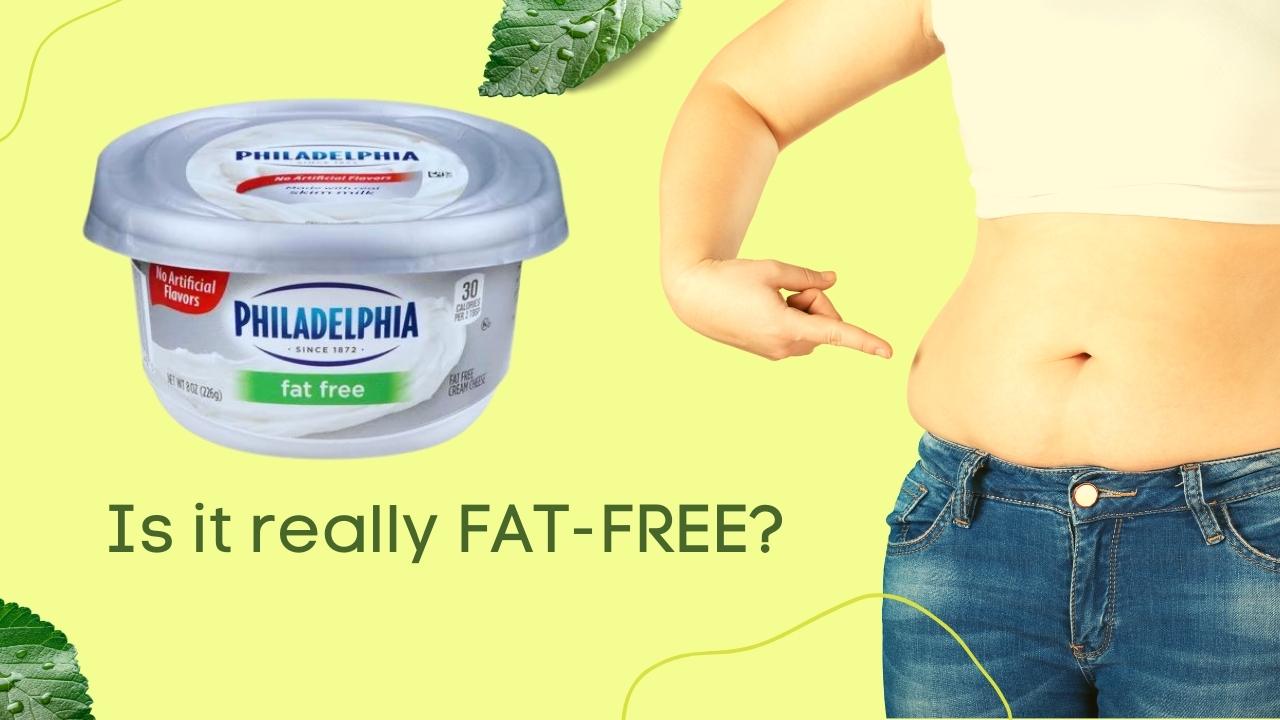The bright blue lid and bold “FAT-FREE” label on a tub of Philadelphia Cream Cheese can feel like a clear victory for health-conscious shoppers. It promises the creamy satisfaction we crave without the dietary baggage of fat. But in the intricate world of food science, nutritional labeling, and marketing, what does “fat-free” really mean? Is it the guilt-free pass it appears to be?
Here at go4healthnfitness.com, we believe that wellness is found at the intersection of scientific truth and informed choices. Our mission is to pull back the curtain on food labels and empower you with a clear, evidence-based understanding of what you’re actually eating. Today, we’re putting Kraft’s popular fat-free offering under the microscope. We will analyze the official nutrition facts, dissect every ingredient, and compare it to its full-fat counterparts to deliver the definitive verdict.
Key Takeaways
For those short on time, here’s the condensed analysis of what you need to know about Philadelphia Fat-Free Cream Cheese:
- “Fat-Free” Isn’t “Zero-Fat”: According to the U.S. Food and Drug Administration (FDA), a product can be labeled “fat-free” if it contains less than 0.5 grams of fat per serving. This is a small amount, but it’s not strictly zero, especially if you consume more than the recommended serving size.
- Highly Processed Ingredients: To achieve its creamy texture without fat, the product relies on a list of stabilizers and thickeners, including whey protein concentrate, carob bean gum, and xanthan gum. These are generally recognized as safe but are markers of a highly processed food.
- Sodium Content is Significant: While low in calories and fat, a single 2-tablespoon serving contains 200mg of sodium, which is about 9% of the recommended daily value. This can add up quickly.
- The Verdict: While it meets the legal definition of fat-free and is a useful tool for strict calorie-controlled diets, its highly processed nature and sodium content mean it shouldn’t automatically be considered a “health food.” Whole-food alternatives may be superior for overall wellness.
The “Fat-Free” Claim Unpacked 📋
Before we dive into the product itself, it’s crucial to understand the rules of the game. The term “fat-free” is a nutrient content claim regulated by the FDA to prevent misleading marketing.
The official definition, as outlined in the Code of Federal Regulations (Title 21, Part 101), states that a food can bear the “fat-free” label if it contains less than 0.5 grams of total fat per Reference Amount Customarily Consumed (RACC) and per labeled serving.
What does this mean for you?
- Serving Size is Everything: The RACC for cream cheese is 30 grams, which corresponds to the 2-tablespoon serving size listed on the tub. If you stick to this portion, you are indeed consuming a negligible amount of fat. However, if you’re known to spread a thick layer on your morning bagel, you might be consuming double or triple the serving size—and therefore, potentially more than 0.5 grams of fat. This is a critical piece of understanding food nutrition facts.
- It’s a Game of Rounding: Food manufacturers can legally round down. If a serving contains 0.49 grams of fat, it can be listed as 0 grams on the Nutrition Facts panel.
“The ‘fat-free’ claim is a perfect example of why consumers need to look beyond the front-of-package marketing,” notes Laura M. Miller, RDN, a registered dietitian specializing in food labeling. “The real story is always on the back, in the nutrition facts and the ingredient list. The regulations are designed for standardization, but they can create a ‘health halo’ around products that are still highly processed.”
Kraft Philadelphia Fat-Free Cream Cheese: Nutrition Facts Deep Dive 📊
Let’s look at the official numbers for a standard 30-gram (2 tbsp) serving:
- Calories: 30
- Total Fat: 0g
- Saturated Fat: 0g
- Trans Fat: 0g
- Cholesterol: 5mg
- Sodium: 200mg
- Total Carbohydrates: 4g
- Dietary Fiber: 0g
- Total Sugars: 3g (Includes 2g of added sugars)
- Protein: 4g
At first glance, the fat free cream cheese nutrition profile is impressive for anyone managing their weight or fat intake. Thirty calories for a creamy spread is very low. The 4 grams of protein are also a welcome bonus, primarily coming from the added milk and whey proteins.
However, two numbers warrant a closer look: the sodium and the sugar. With 200mg of sodium, it’s a moderately salty product. The 3 grams of sugar, 2 of which are added, are used to improve flavor in the absence of fat.
Ingredient Analysis 🧐
So, if it’s not fat, what gives it that creamy, spreadable texture? The answer lies in the ingredient list, which reveals the extent of food science engineering required to create a fat-free mimic.
Here is the full list of Philadelphia cream cheese ingredients for the fat-free version:
- Pasteurized Nonfat Milk and Milkfat: This forms the base. “Nonfat milk” is skim milk.
- Whey Protein Concentrate: Whey is a protein byproduct of cheesemaking. Concentrating it creates a powder that adds protein and, crucially, helps with texture and water retention, making the product thicker.
- Cheese Culture: The live and active cultures (bacteria) that are essential for fermenting milk to create the characteristic tangy flavor of cheese.
- Salt: For flavor and preservation.
- Carob Bean Gum: A natural vegetable gum extracted from the seeds of the carob tree. It’s a powerful thickening and stabilizing agent, preventing ice crystals from forming and giving the cream cheese a smooth, uniform body.
- Xanthan Gum: Another common food additive made by fermenting sugar with Xanthomonas campestris bacteria. It’s an exceptionally effective thickener and emulsifier, ensuring the water and other ingredients don’t separate.
- Guar Gum: Like carob bean gum, this is another thickener derived from a plant (the guar bean). The combination of these three gums (carob, xanthan, guar) creates a powerful synergistic effect, producing a stable, thick, and creamy texture without a single drop of cream.
- Sorbic Acid (as a preservative): An antimicrobial agent used to prevent the growth of mold, yeast, and fungi, extending the product’s shelf life.
- Vitamin A Palmitate: Since the fat has been removed, the fat-soluble vitamins (like Vitamin A) naturally present in milkfat are also gone. Vitamin A Palmitate is added to fortify the product and replace what was lost.
This list is a masterclass in understanding processed cheese ingredients. While these additives are approved by the FDA and considered safe for consumption, their presence is a clear indicator that the food has been significantly engineered.
Product Comparison: Fat-Free vs. Reduced Fat vs. Original 🧀
Context is key. How does the fat-free version stack up against its siblings? This table provides a side-by-side Kraft cream cheese review for a 30g serving.
| Nutrient | Fat-Free | 1/3 Less Fat | Original |
|---|---|---|---|
| Calories | 30 | 70 | 100 |
| Total Fat (g) | 0g | 6g | 10g |
| Saturated Fat (g) | 0g | 3.5g | 6g |
| Carbohydrates (g) | 4g | 2g | <1g |
| Protein (g) | 4g | 2g | 2g |
| Sodium (mg) | 200mg | 115mg | 105mg |
This comparison reveals the nutritional trade-offs:
- Fat & Calories: The difference is stark. You save 70 calories and 10 grams of fat by choosing the fat-free option over the original.
- Protein: The fat-free version has double the protein, thanks to the added whey protein concentrate.
- Carbohydrates: To compensate for the lack of fat, the fat-free version has more carbohydrates and sugar.
- Sodium: This is the most surprising trade-off. The fat-free version has nearly double the sodium of the original. Fat is a major carrier of flavor, and when you remove it, you often need to add more salt and sugar to make the product palatable.
The Health Verdict: Is Fat Free Cream Cheese Healthy? ✅ / ❌
So, we arrive at the central question: is this a “healthy” choice? The answer is nuanced and depends entirely on your personal health goals, dietary philosophy, and what you’re comparing it to.
Pros (The Good):
- ✅ Low-Calorie Density: For individuals in a calorie deficit for weight loss, this product can be a valuable tool. It allows for the enjoyment of a creamy texture in recipes and on bagels for very few calories.
- ✅ Virtually No Fat: It’s an excellent choice for those on medically-necessary low-fat or very-low-fat diets (e.g., for certain gallbladder or pancreatic conditions).
- ✅ Higher in Protein: The extra 2 grams of protein per serving compared to the original can contribute to satiety.
Cons (The Not-So-Good):
- ❌ Highly Processed: The long ingredient list filled with gums and concentrates is the opposite of a whole food. Diets rich in whole, unprocessed foods are consistently linked to better long-term health outcomes.
- ❌ High in Sodium: The elevated sodium content is a significant drawback, especially for individuals monitoring their blood pressure or overall sodium intake.
- ❌ Lacks Healthy Fats: While it avoids saturated fat, it also provides none of the healthy, satiating fats that are essential for hormone production, vitamin absorption, and overall cellular health.
- ❌ Taste and Texture: Many consumers report a noticeable difference in taste and texture, sometimes describing it as more “gummy” or “tangy” than the original, a direct result of the gum-based thickeners.
“When clients ask me about products like this, I encourage them to think about their ‘why’,” says Miller. “If the ‘why’ is purely calorie control for a short-term goal, it has a place. But if the ‘why’ is long-term, holistic health, I’d guide them towards options with simpler ingredient lists, like hummus, avocado, or even a small serving of the original full-fat cream cheese, which is far less processed.”
Who Is It Good For?
- A good fit for: Individuals on a strict, calorie-controlled weight loss plan who find it helps them adhere to their diet.
- A poor fit for: Individuals following a whole-foods-based lifestyle (like Paleo or clean eating), those on low-sodium diets, or anyone who prioritizes nutrient density and minimal processing over low-calorie counts.
Conclusion: The Final Verdict
So, is Kraft Philadelphia Fat-Free Cream Cheese truly fat-free? By the FDA’s legal definition, yes. For a standard serving, it delivers on its primary promise.
But the more important question is whether it’s a healthy choice. And there, the answer is more complex. It is a marvel of food technology—a product engineered to deliver a specific sensory experience without its most defining ingredient. It succeeds as a low-calorie, high-protein alternative, but it does so at the cost of being a highly processed food with a high sodium content and a list of additives.
At go4healthnfitness.com, we advocate for informed decisions. This cream cheese isn’t inherently “bad,” but it’s not the unambiguous health hero its label might suggest. It’s a tool, and its value depends entirely on the job you’re hiring it to do. For most people seeking genuine wellness, prioritizing less processed foods with shorter ingredient lists is a more reliable path to long-term health.
Frequently Asked Questions (FAQ)
1. What is the exact serving size for Kraft’s fat-free cream cheese? The recommended serving size is 30 grams, which is equivalent to 2 tablespoons. All nutritional information on the label is based on this amount.
2. Why does fat-free cream cheese contain gums? Fat provides a creamy texture and “mouthfeel.” When the fat is removed, manufacturers use gums (like xanthan, carob bean, and guar gum) as thickening and stabilizing agents to replicate that creaminess and prevent the product from becoming watery.
3. Is fat-free cream cheese keto-friendly? No, it is not ideal for a standard ketogenic diet. While it’s low in fat, it contains 4 grams of carbohydrates per serving. Traditional keto diets prioritize high fat, moderate protein, and very low carbohydrates. The original, full-fat cream cheese is a much better fit for the keto diet.
4. Can you bake with fat-free cream cheese? Yes, but with caution. The lower fat and higher water content can alter the texture of baked goods. It often results in denser, chewier, or more rubbery results compared to full-fat cream cheese, especially in recipes like cheesecake.
Sources
- U.S. Food and Drug Administration. (2024). CFR – Code of Federal Regulations Title 21, Part 101 – Food Labeling. Retrieved from https://www.accessdata.fda.gov/scripts/cdrh/cfdocs/cfcfr/CFRSearch.cfm?fr=101.62
- U.S. Department of Agriculture, Agricultural Research Service. (2024). FoodData Central. Retrieved from https://fdc.nal.usda.gov/
- Kraft Heinz Company. (2024). Philadelphia Cream Cheese Product Information. Retrieved from the official product website.





